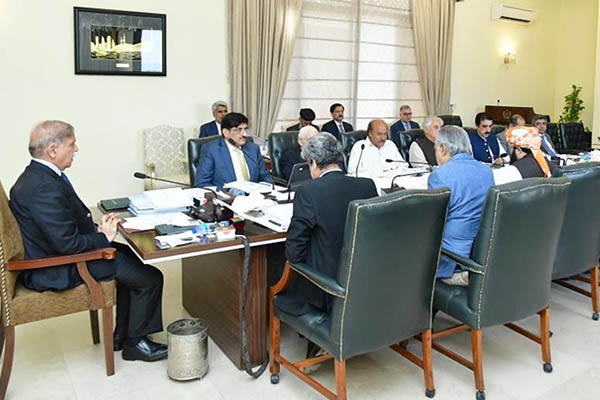
P.M. Sharif chairs a meeting of the National Economic Council. Photo courtesy PID
A meeting of the National Economic Council (NEC), chaired by Prime Minister Shehbaz Sharif, on Tuesday approved an Annual Development Plan (ADP) of Rs. 2.709 trillion for fiscal year 2023-24, roughly 24 percent higher than the ongoing fiscal year’s estimated Rs. 2.19 trillion.
“The total national outlay contains the development budget of Punjab and Khyber-Pakhtunkhwa for only four months [the tenure of the caretaker set-up], but if their full budget is included in the ADP, it will exceed Rs. 3 trillion,” Planning Minister Ahsan Iqbal told media after the meeting. He said the ADP included a federal Public Sector Development Program (PSDP) of Rs. 1.15 trillion, and cumulative provincial annual development plans of about Rs. 1.159 trillion.
In briefings to the NEC, participants were informed that the latest census had determined Pakistan’s population growth rate was 3.6 percent, meaning the country’s population could exceed 340 million by 2035 if steps are not taken to implement family planning. To cope with the growing population, the participants were told, Pakistan would need to grow its investment-to-GDP ratio from 13.6 percent to at least 22 percent. This would also require the country to achieve GDP growth of 6-8 percent annually if it aims to curtail poverty to 15 percent over the next 10 years.
According to briefings at the NEC, the federal PSDP would be arranged through domestic resources of Rs. 875 billion and Rs. 75 billion foreign assistance. Similarly, the provincial ADPs include foreign assistance of Rs. 569 billion, with Punjab’s budget estimated at Rs. 426 billion; Sindh Rs. 617 billion; KP Rs. 268 billion; and Balochistan Rs. 248 billion. In total, foreign assistance would total Rs. 644 billion, while the remainder would be domestically secured.
The NEC has further proposed allocation Rs. 267 billion for transport and communication; Rs. 100 billion for the water sector; Rs. 89 billion for the energy sector; and Rs. 43 billion for physical planning and housing. It has set the share of education at Rs. 82 billion; health at Rs. 90 billion; and Rs. 90 billion for parliamentarian schemes under the sustainable development goals’ achievement program. The ADP also envisions Rs. 57 billion for the merged districts of KP; Rs. 32.5 billion for Azad Jammu and Kashmir; and Rs. 28.5 billion for Gilgit-Baltistan.
GDP growth
The forum has set a GDP growth target of 3.5 percent, with an estimated 3.6% growth in the services sector; 3.5%in agriculture; and 3.4% in industry. It has projected inflation to reduce to around 21 percent next year, while the target for exports has been set at $30 billion. However, in its Global Economic Prospects report, the World Bank set Pakistan’s estimated GDP growth at 2 percent, citing lasting effects from last year’s floods; limited foreign exchange reserves; and a nearly 25 percent reduction in industrial production over the past fiscal year.
“With dwindling foreign exchange reserves and stagnant remittances, the government has increased exchange rate flexibility, allowing the Pakistani rupee to depreciate by 20 percent since the start of the year,” it said. “Consequently, headline consumer price inflation has risen sharply, reaching 38 percent in the year to May, its highest level since records began in the late 1970s.”
The report said it expected poverty to decline over the next fiscal year, though warned that this would likely be a slow recovery.
